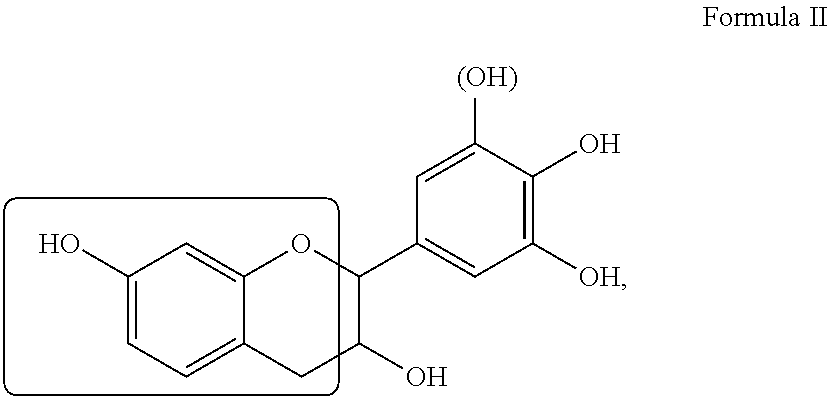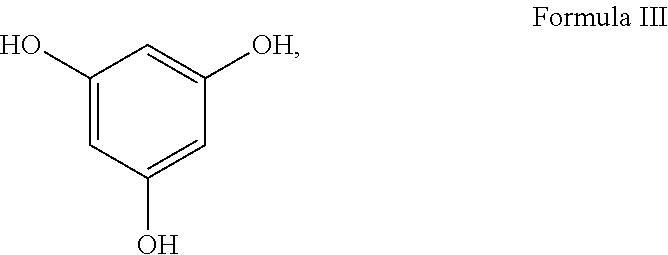Methods for making lignocellulose composite products with oxidative binders and encapsulated catalyst
a technology of lignocellulose and oxidative binders, which is applied in the field of making lignocellulose composite products with oxidative binders and encapsulated catalysts, and can solve the problems of reducing product strength, reducing resin shelf life, and prolonging cure tim
- Summary
- Abstract
- Description
- Claims
- Application Information
AI Technical Summary
Benefits of technology
Problems solved by technology
Method used
Image
Examples
example 1
A “One-Pot” Process Using Iron EDTA without Excess Chelate
[0220]Base Mixture 1:
[0221]To the blend tank equipped with an agitator, and heated to about 63° C., wax (about 337.5 g), water (about 505.5 g), an aqueous ammonium lignosulfonate solution (about 3,896 g), and iron EDTA (about 82 g) were added and agitated. The emulsion was homogenized in a two pass system at about 24.1 MPa and then at about 3.45 MPa and cooled to about 25° C. to produce a Base Mixture 1 contained ammonium lignosulfonate (about 82.3%), iron EDTA (about 3.4%), and wax (about 14.3%), based on dry weight of the Base Mixture 1.
[0222]Lignocellulose Binder Mixture 1:
[0223]A plurality of lignocellulose substrates (face-grade particleboard wood particles of Southern Yellow Pine having a moisture content of about 2.5 wt % to about 3 wt %) in the amount of about 2,100 g, was placed in a mixer having a volume of about 0.0283 m3. While mixing, the following components of the binder system were applied in the form of a fin...
example 2
A Step-Wise Addition Process Using Iron EDTA without Excess Chelate
[0224]Base Mixture 2:
[0225]To the blend tank equipped with an agitator, water (about 505.5 g) and a surfactant (about 60 g of ammonium lignosulfonate, it is 7% of total wax and water) were added. The blend tank was heated to about 63° C. and molten wax (about 337.5 g) was added during agitation. While mixing, iron EDTA (about 82 g) was added to the mixture. The emulsion was homogenized in a two pass system at about 24.1 MPa and then at about 3.45 MPa and cooled to about 25° C. to produce a wax emulsion with iron EDTA (the water and wax mixture).
[0226]The emulsion NV % value, although not measured, can be about 40% to about 60%, or about 45% to about 50%. The pH value, although not measured, can be about 7 to about 9, or about 7.5 to about 8.0 at a temperature of about 25° C. The Brookfield viscosity, although not measured, can be less than 800 cPs measured with #61 spindle at 60 rpm at a temperature of about 25° C.
[0...
example 3
A “One-Pot” Process Using Iron EDTA with Excess Chelate (Tetrasodium EDTA)
[0231]Base Mixture 3:
[0232]To the blend tank equipped with an agitator, and heated to about 63° C., wax (about 337.5 g), water (about 505.5 g), an aqueous ammonium lignosulfonate solution (about 3,896 g), and iron EDTA (about 82 g) were added and agitated. The emulsion was homogenized in a two pass system at about 24.1 MPa and then at about 3.45 MPa and cooled to about 25° C. Next, about 0.094 wt % of tetrasodium EDTA (about 39 wt % aqueous mixture) was blended with the emulsion to produce Base Mixture 3, where the amount of each component was based on the dry weight of the lignocellulose substrates (described below).
[0233]Base Mixture 3 contained ammonium lignosulfonate (about 81.01 wt %), iron EDTA (about 3.4 wt %), wax (about 14.05 wt %), and tetrasodium EDTA (about 1.54 wt %), based on dry weight of Base Mixture 3.
[0234]Lignocellulose Binder Mixture 3:
[0235]A plurality of lignocellulose substrates (face-gr...
PUM
| Property | Measurement | Unit |
|---|---|---|
| temperature | aaaaa | aaaaa |
| molar ratio | aaaaa | aaaaa |
| molar ratio | aaaaa | aaaaa |
Abstract
Description
Claims
Application Information
 Login to View More
Login to View More - R&D
- Intellectual Property
- Life Sciences
- Materials
- Tech Scout
- Unparalleled Data Quality
- Higher Quality Content
- 60% Fewer Hallucinations
Browse by: Latest US Patents, China's latest patents, Technical Efficacy Thesaurus, Application Domain, Technology Topic, Popular Technical Reports.
© 2025 PatSnap. All rights reserved.Legal|Privacy policy|Modern Slavery Act Transparency Statement|Sitemap|About US| Contact US: help@patsnap.com



